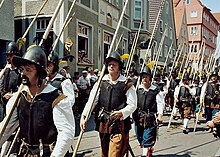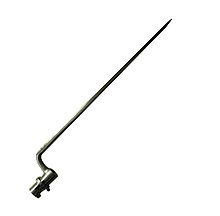Pikemen
The pikemen represented the heavy infantry in large parts of Europe from the 15th to the 17th century and were named after their main weapon, the pike ( spit ). The name was borrowed at the beginning of the 16th century from the French word pique , which is derived from the verb piquer ("to sting").
history
The spit turned out to be an effective weapon in combat against cavalry units . For this purpose, the pikemen fighting in deep formations needed less intensive training than knights or cuirassiers and were also extremely cheap to equip.
As a defensive weapon against cavalry, their range should exceed the length of the knightly lances . In the technique of the riposte , used propped up on the ground, it served to let the attacking enemy run aground and to stop the oncoming cavalry.
Forerunners of the pike units can be found in Scotland as early as the late 13th century , where the rebellious Scots formed dense formations of spear-bearers, the so-called Schiltrons . This tactic was perfected in Switzerland , where Swiss armed first with halberds and later mainly with spears inflicted heavy defeats on the Austrian knights in several battles. The appearance of the pikemen on the battlefields of Europe accelerated the decline of chivalry that had begun in the 14th century and cleared the way for the mercenaries of the 15th to 17th centuries. The Swiss fought in extremely large, deeply staggered formations, the so-called heap of violence . A single gang of violence could contain several thousand pikemen. If Swiss mercenaries were initially used in other regions of Europe, numerous pike units were formed outside of Switzerland by the 16th century.

The tactic of the massive use of spikes was improved outside of Switzerland by the mercenaries by increasing the mobility of the formations through a deeper staggering. In addition, in the course of the 16th century the pikemen were increasingly supplemented by (firearms) arquebuses - and then also by musket shooters. In Spain people started to post the musket shooters at the corners of the violence heap. The Spanish pike formations were usually 50 men wide and 30 men deep. This formation was also adopted in other parts of Europe and was known as the Tercio or Spanish Square .
During the 16th century the pikemen often fought one another in close combat . Up to the second half of the 17th century, many pikemen were protected by breast and back armor and an open helmet . In addition, most of the pikemen were armed with a melee weapon such as a sword , rapier or dagger . If a formation of pikemen succeeded in breaching an enemy unit, mercenaries armed with halberds or sometimes two-handed swords would advance immediately to break into the enemy lines. If a spade bearer fell in battle, the man behind him would move up immediately. In a battle between two pike formations, these usually wedged, which is why the addition of arquebus archers to the violence was indispensable. It is possible that mercenaries armed with two-handed swords were used to enable a break-in in a deadlocked combat situation. In Tercio , Spain , there were no longer any halberdiers; the pikemen were now the only hand-to-hand combatants in the infantry. The maneuvering of the large pike formations was extremely difficult and required intensive military drill. In addition, drummers were used to set the march pace from the late 15th century. Sergeants were posted at the edges of the formation to take on an organizing function. The sergeants were armed with a halberd, which not only served as a symbol of rank, but also as a tool to hold the formation together. If a pikeman did not march in step with the others, he could expect a sergeant to hit him with the flat side of the halberd as punishment. In the battle, a pikemen was additionally maneuvered by loud commands.
The numerical ratio of spade bearers to musket shooters shifted in the course of the Thirty Years' War in favor of the latter. The advantage of the pikemen over the cavalry was also offset, as they developed counter-tactics like the Caracolla . In the mid-17th century, pikemen made up less than a third of the infantry in most European armies. Even so, at that time they still seemed indispensable for defending against cavalry . It was not until the perfection of volley tactics among handguns and, above all, the spread of the bayonet and pig's feathers in the second half of the 17th century, that pikemen gradually became superfluous.
Pikemen were at first quite respected, as their task required a high level of discipline and they could successfully fight even heavy cavalry units. In the course of time, however, their reputation declined significantly, as they were assigned to the musket shooters at the latest by the time of the Thirty Years War and were confronted with a cavalry that avoided frontal attacks. Hans Jakob Christoffel von Grimmelshausen had the protagonist of his work "The Strange Springinsfeld" sneer at the pikemen in Chapter 13:
"And then, heroically, I believe that the one who refuses a piqué (whom he could otherwise spare) murdered an innocent man / and can never answer for such a death; then whether these poor pushing oxen (they are called by that mocking name) are created in the same way / to protect their brigades from the hacking of the Reutter in the open field / so they do no harm to themselves / and history is right to the one or the other in his long spies runs. In sum, I have seen a lot of sharp occasions my day / but seldom noticed / that a Piquenir had killed someone. "
The French army disbanded its last pikemen in 1703. England followed in 1704 , and in 1708 the Dutch army also abandoned the use of pikes. Only in Russia and Sweden , which u. a. deployed many pikemen in the battle of Poltava, pikemen were deployed (in addition to Berdishi- bearing riflemen) until the 1720s, and they proved to be effective against the Turkish cavalry. The bayonet can be seen as the successor to the pike, and there were generals up until the beginning of the 20th century who considered bayonet attacks to be a sensible tactic - often with terrible results for their own men.
Equipment of the pikemen
In the course of time, various items of equipment such as heavy pikeman armor or sword staff were used by pikemen .
Phrase
The saying “learn something from the bottom up” has developed from the pikeman, since a soldier who was just recruited and was not able to bring in a firearm or a horse himself was equipped with a pike. The craft of war had to be learned "from scratch" for soldiers with no experience.
Philistines were city dwellers who were armed with pikes for defense. Today this term is used disparagingly. This devaluation (today too bourgeois opinions are called "stuffy") comes from these city guards, as they also had the task of driving people who did not live in the city and had no right to live there in the evening before the gate closed , not least by threatening them and apply their pike.
Museum reception
In the Military History Museum in Vienna many original pikes from the 17th century are on display. There are also several figurines of imperial pikemen from the time of the Thirty Years War, which are also equipped with swords. In Graz Landeszeughaus, the largest surviving arsenal in the world, can also be seen from the 16th and 17th centuries, a large number of pikes.
Web links
- Excerpt from a documentary about pikemen, in which Swiss soldiers re-enact the pike formations ( YouTube video)
Individual evidence
- ↑ Example of a pikeman armor, Germany around 1600
- ^ Manfried Rauchsteiner , Manfred Litscher (Ed.): The Army History Museum in Vienna. Graz, Vienna 2000, p. 11.




